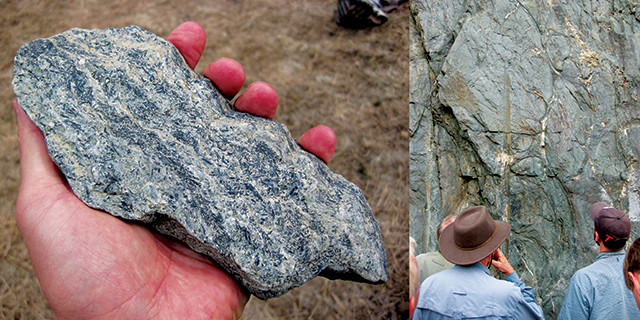
by Mary Caperton Morton Friday, April 1, 2016

Blueschist (left) and greenschist (right) are both metamorphic rocks that form in subduction zones, but under different thermodynamic conditions. Credit: both: Callan Bentley.
There’s ample evidence of active plate tectonics during the Phanerozoic, as far back as 540 million years ago. But before that, the signatures of subduction are less clear, largely because plate tectonics recycles older crust back into Earth’s mantle, continuously destroying evidence of its own past. Based on petrological, isotopic and structural clues preserved in some of the most ancient rocks on Earth, “most researchers would say that subduction began sometime in the Archean,” which lasted from 4 billion to 2.5 billion years ago, says Richard Palin, a metamorphic geologist at the Johannes Gutenberg University Mainz in Germany and lead author of the new study, published in Nature Geoscience.
Blueschist is the smoking gun for the sort of low-temperature, high-pressure metamorphism produced today in subduction zones. “To make blueschists, you need to take basaltic rocks down to a depth of at least 15 kilometers, and then bring them back to the surface very quickly — usually in mountain-building collisions — before they re-equilibrate back to basalt,” says Jun Korenaga, a geophysicist at Yale University who was not involved in the new study but wrote an accompanying commentary in Nature Geoscience. Today, blueschists are most commonly found in the Alps, Japan and the west coast of North America.
“The oldest blueschists are only 700 million to 800 million years old, and some [researchers] have claimed that this must date the onset of plate tectonics,” Palin says. But the reason older blueschists are absent in the rock record probably isn’t because plate tectonics was not yet underway, but because of the different thermodynamic conditions that prevailed inside Earth long ago. The hotter temperatures in early Earth’s young mantle would have melted magnesium-rich olivine more readily than today, producing especially magnesium-rich oceanic crust. Using computer models to create mineral phase diagrams, Palin and his co-author Richard White, also at Mainz, showed that blueschist cannot form from such magnesium-rich rock during subduction. Instead, the process would have produced greenschist, a metamorphic rock associated today with low-temperature, low-pressure conditions.
“This study is quite refreshing, as it proposes a novel way of interpreting the widely known observation of the lack of older blueschist,” Korenaga says. “It’s no wonder that we could not find blueschist in those ancient orogens that formed when Earth was much hotter than at present — we were looking for rocks that simply could not have been generated.” The suggestion from the phase diagrams that greenschist would have formed instead can “easily be checked by going back to the original rock samples and analyzing their mineral chemistry,” Korenaga says. Few such studies looking specifically at greenschist in this context have been done to date, he says.
The findings also have implications for water transport between the mantle and the early oceans, Palin says. Greenschist is known to hold more water than blueschist, meaning that more water could be transported into the mantle through subduction. “When water is taken down into Earth through subduction, the rocks then heat up, dehydrate and lose their water,” he says, which helps produce magma above the subducting plate. “If you take more water down, you can generate more arc magmas, which produces more voluminous melting, which could lead to more volcanic activity.”
© 2008-2021. All rights reserved. Any copying, redistribution or retransmission of any of the contents of this service without the expressed written permission of the American Geosciences Institute is expressly prohibited. Click here for all copyright requests.